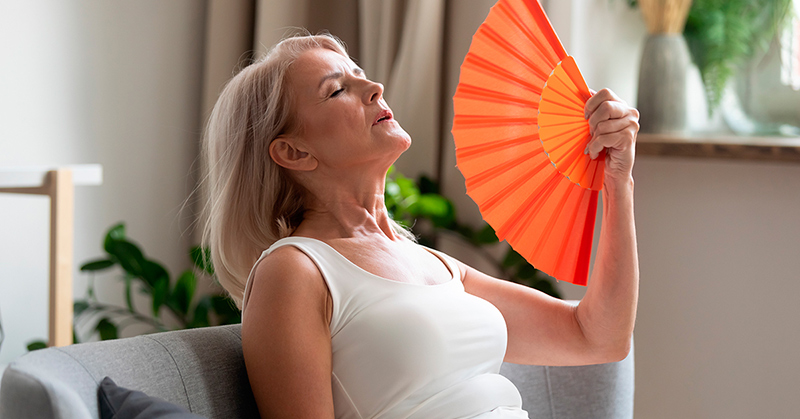For Menopause, Chaste Tree Berry in a standardized concentrate is a potent adaptogen with estrogen-balancing effects, which significantly relieves hot flashes, insomnia, and mood changes. An adaptogen is a botanical that encourages and restores normal function by either enhancing a deficiency or calming over-activity, whichever the target organ needs: an example of the intelligence of nature. Chaste tree berry is obtained from the dried ripe fruit of the chaste tree, with its first documented use as a women’s health botanical at least 2500 years ago in ancient Greece. Known in Latin as vitex agnus-castus, the herb chaste tree berry has been in use since Greek, Roman, and medieval times for menopausal symptoms.

Menopause is a transitional phase from fertility to non-fertility, in which there is a gradual reduction in ovarian function accompanied by unpredictable hormonal fluctuations as estrogen production declines. Symptoms vary in intensity and duration from woman to woman. The pituitary is a master gland overseeing the female hormone system and maintaining cyclical estrogen and progesterone release from the ovaries. Chaste tree berry acts as a pituitary adaptogen: It helps that organ to boost insufficient ovarian hormone output, to maintain optimal estrogen and progesterone levels, or to calm excessive hormone secretion, thus helping restore balance to hormone levels. This gentle and balanced action occurs by virtue of the chaste tree berry’s particular chemical structure: It is able to bind to estrogen receptors and then exert biological activity of an estrogen- enhancing or calming nature. In addition to its estrogen-binding affinity, chaste tree berry also corrects the deficiency of progesterone: It acts as a dopamine agonist to improve menopausal symptoms by reducing the secretion of prolactin.1
Biologically, chaste tree berry balances the pituitary’s output of FSH and LH, both of which can shift at menopause. Follicle stimulating hormone, FSH, in general encourages the first half of the menstrual cycle, the follicular phase when a new egg starts to ripen and estrogen levels rise. After ovulation, the second half of the cycle begins: This is the luteal phase that lasts about fourteen days, when luteinizing hormone or LH is high and progesterone dominates the hormonal landscape. Chaste tree berry helps to stabilize both halves of the menstrual cycle, as long as the body has enough hormone reserves to respond. Herbs in general encourage or “invite” the body to maintain steady function, which works as long as the organs have the capacity respond and make hormones. This adaptogenic effect on balancing pituitary function is one main mechanism by which chaste tree berry eases menopausal symptoms.
For centuries, healers have used botanicals, and herbal remedies have been handed down to us from Native American lore, traditional Asian medicine, and Indian Ayurveda. Today, scientists investigating their actual benefits and mechanisms of action find many have proven safe and effective. In recent years, it has also emerged that chaste tree berry, through its dopaminergic action, also improves the emotional distress of menopause, because a decrease in dopaminergic tone is correlated with psychological symptoms.2
Research has focused particularly on chaste tree berry’s main active ingredients, including agnuside: These are especially helpful for the vasomotor symptoms of menopause: night sweats, hot flashes, and flushes. A 2011 study has shown how, with chaste tree berry, the daily number of hot flushes after 8 weeks of treatment was significantly decreased compared with a group of women taking placebo. Additionally, the group treated with chaste tree berry also showed a statistically significant reduction of severity of hot flushes, night-time sweating, insomnia, anxiety, depression, lack of energy, and headaches compared with the control group.3 The symptoms were less intense, and lasted for a shorter time, with less disruption to sleep and daily comfort. Aucubin is the other primary glycoside in chaste tree berry with potent gynecological benefits. We have seen patients receive excellent symptom relief with 0.6% aucubin formulas.
Chaste tree berry is also known for having analgesic and opioidergic, or pain-relieving, action. This suggests the possibility of a topical formulation for treating dyspareunia: difficult or painful sexual intercourse which is sometimes related to menopause. More research is needed to focus on the possible activity of chaste tree berry on sexual desire in menopausal women, as available data shows it is worth investigating.4
In our clinic, our patients have achieved excellent results taking a daily dose of two capsules daily of Chaste tree berry extract 400-500mg, rich in the potent active constituent aucubin standardized to a high 0.6% percentage, that also contains 50-75mg of whole chaste tree berry.
Recommendations:
Capsules of chaste tree berry extract 400-500mg, with aucubin standardized to a high 0.6% percentage, including 50-75mg of whole chaste tree berry, or as directed by your healthcare provider. Like most herbs, it is best absorbed between meals.
References
- Leo, V. D., et al. “Phyto-Oestrogens and Chaste Tree Berry: A New Option in the Treatment of Menopausal Disorders.” J Women’s Health Care 3.182 (2014): 2167-0420.
- van Die MD, Burger HG, Teede HJ, Bone KM (2009) Vitexagnus-castus (Chaste-Tree/Berry) in the treatment of menopause-related complaints. J Altern Complement Med 15: 853-862.
- Abbaspoor Z, AzamHajikhani NA, Afsharl P (2011) Effects of Vitex-agnus-castus on menopausal early symptoms in postmenopausal women: a randomized double-blind, placebo-controlled study. Brtt J Med & Med Res 1:132-140.
- Mazaro-Costa R, Andersen ML, Hachul H, Tufik S (2010) Medicinal plants as alternative treatments for female sexual dysfunction: utopian vision or possible treatment in climacteric women? J Sex Med 7: 3695-3714.
- Rafieian-Kopaei M, Movahedi M. Systematic Review of Premenstrual, Postmenstrual and Infertility Disorders of Vitex Agnus Castus. Electron Physician. 2017 Jan 25;9(1):3685-3689.